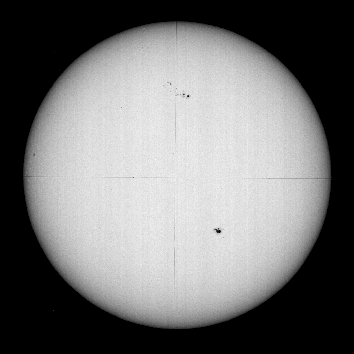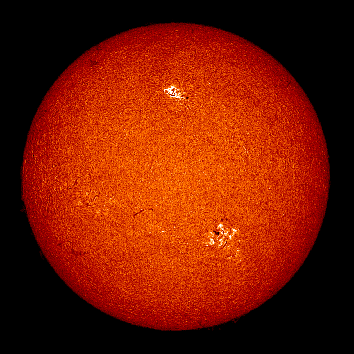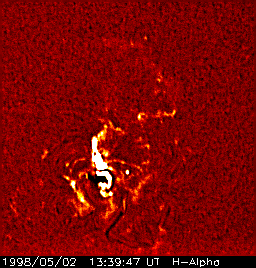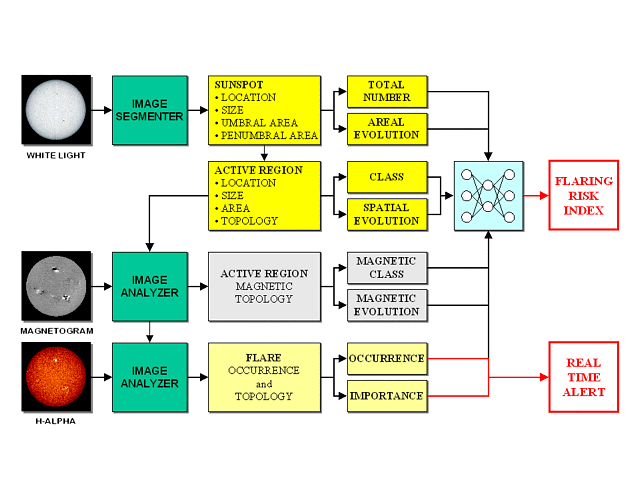| GSP Study Archive |
| Space Weather Studies |
| Applications Pilot Project |
| Feasibility Studies |
| CDF Space Weather Study |
| Past Workshops |
| Past Publications |
THE SOLAR SURVEILLANCE PROGRAM AT THE KANZELHÖHE SOLAR OBSERVATORY: NEW FACILITIES FOR HIGH SPEED DIGITAL IMAGING AND DYNAMIC EVENT TRACKING
M. Messerotti1, W. Otruba2, A. Warmuth3, A. Cacciani4P.F. Moretti4, A. Hanslmeier3, M. Steinegger3
1Astronomical Observatory, Via G.B. Tiepolo 11, I-34131 Trieste, Italy,
2Sonnenobservatorium Kanzelhöhe, A-9521 Treffen, Austria
3Institut für Astronomie, Karl-Franzens-Universität Graz, Universitäts Platz 5, A-8010 Graz, Austria
4Department of Physics, University of Rome "La Sapienza", P. A. Moro 2, I-00185 Roma, Italy
Abstract
1 INTRODUCTION
2 SOLAR SURVEILLANCE FACILITIES
3 AN EXAMPLE FLARE OBSERVATION DURING A SOHO/UVCS CAMPAIGN
4 THE DESIGN OF A FLARE MONITORING AND ALERTING SYSTEM
ACKNOWLEDGMENTS
REFERENCES
Abstract 
The Kanzelhöhe Solar Observatory (Austria) has been devoted to multiwavelength synoptic observations of the sun for a long time in the frame of a long-term Solar Surveillance Program. Recently the observing capabilites were boosted by two new instruments for full-disk imaging: a digital Ha camera and a Magneto-Optical Filter (MOF) system. In this frame, we sketch the feasibility of a fully digital flare survey and a quasi-real time analysis system based on an artificial neural network, which might be relevant to the prediction of solar events affecting the solar-terrestrial environment.
Key words: solar surveillance; digital imaging; neural networks.
1 INTRODUCTION 
The Solar Observatory Kanzelhöhe is affiliated to the Institute of Astronomy of the Karl-Franzens University Graz, Austria. Located in Central Europe on a mountain south of the Alps (N 46° 40.7¢ E 13° 54.4¢ Elev. 1526m), it is operated continuously all over the year gathering about 300 days with totally 2000 hrs of observations. Solar Surveillance Instruments allow multi-spectral, full-disk patrol observations. Recently the capabilites have been boosted by the introduction of two new instruments: the high cadence digital Ha camera and the Magneto-Optical Filter (MOF). A new imaging instrument which extends the spectral range is under construction and spectrographic investigations will be possible after the completion of the Kanzelhöhe Vacuum Telescope. With the installation of these new devices, Kanzelhöhe now possesses a unique variety of instruments for multi-wavelength solar observations, all concentrated in one location and dedicated to the study of solar flares and other activity phenomena. The data archive is open to guest investigators and holds the observations since the foundation in 1943. Observational data are currently provided to the SOHO Synoptic Data Base, Sunspot Index Data Center (Brussels) and the World Data Centers for Solar-Terrestrial Physics at Boulder, Moscow and Meudon. The synoptic digital image archive is made available also via the WWW at the URL http://www.solobskh.ac.at.
2 SOLAR SURVEILLANCE FACILITIES 
Presently White-Light (WL) full-disk synoptic images (see figure 1) are taken on high resolution black and white film at low time cadence (Table 1). The new photometric telescope described later in this section will provide soon WL digital images also at higher time cadence when needed.
A digital Ha camera (Ref. 1) was introduced in order to support the SOHO observing program, which permits a high time cadence and ease of data analysis and storage (Table 2) of Ha images (see figure 2).
The Magneto-Optical Filter is a compact imaging doppler-magnetograph (Ref. 2), which permits to obtain an Na-D intensitygram, a Dopplergram and a longitudinal magnetogram (see figure 3) within one minute (in the present configuration)(Table 3). The development of the full-vector add-on package is in progress.
A new multi-band photometric imaging system (Ref. 4) is in a setup phase. It is based on an apochromatic refractor with a filter wheel for up to 8 interference filters and a digital camera. In the initial phase, three filters will operate (Ca K, B, R) at synoptic cadence (Table 4).
All the above instruments but the WL imager produce digital images physically stored on CD-Rs.
Table 1: Specifications of the WL imaging system.
| Telescope | 13 cm aperture |
| 195 cm focal length | |
| Band | 546.1 nm wavelength |
| 10 nm FWHM | |
| Detector | B/W film |
| Resolution | 1.1 arcsec |
| Cadence | 1 image/day (synoptic) |
Table 2: Specifications of the Ha imaging system.
| Telescope | 10 cm aperture |
| 200 cm focal length | |
| Band | 656.3 nm wavelength |
| 0.07 nm FWHM | |
| Detector | 1K x 1K x 8 CCD |
| Resolution | 2.2 arcsec/px |
| Cadence | 1 image/4 min (synoptic) |
| 1 image/1.5 s (campaign) | |
Table 3: Specifications of the MOF imaging system.
| Objective | 3.6 cm lens |
| 100 cm focal length | |
| Band | Na-D lines |
| Detector | 768 x 512 x 8 (TV) CCD |
| Resolution | 4.3 arcsec/px |
| Cadence | 1 image/day (synoptic) |
| 1 image/160 ms (campaign) | |
| Vel. resol. | 5 (m/s)/px |
| Mag. range | 20-2800 G |
| Eff. depth | 16 bits/px (via image summation) |
| Calibration | Px by px normalization |
Table 4: Specifications of the multi-band imaging system.
| Telescope | 12 cm aperture |
| 114 cm focal length | |
| Band l | 1.[393.3 nm] 2.[409.4 nm] 3.[607.2 nm] |
| Filter FWHM | 1.[1.5 nm] 2.[0.25 nm] 3.[0.5 nm] |
| Detector | 1K x 1K x 8 CCD |
| Resolution | 2.2 arcsec/px |
| Cadence | 1 image/band/day (synoptic) |
| 1 image/band/min (campaign) | |
Figure 1: Full-disk white-light image (May 3, 1998).
Figure 2: Full-disk Ha image (May 3, 1998).
Figure 3: MOF longitudinal magnetogram (May 3, 1998).
3 AN EXAMPLE FLARE OBSERVATION DURING A SOHO/UVCS CAMPAIGN 
>From 24. April to 3. May 1998, the MOF was first used 'in earnest' in support of an UVCS/SOHO campaign, contributing observational runs with a time cadence of one minute and it was joined later by the Ha camera, observing with the same cadence.
3.1 Characteristics of the flare
On May 2, at about 13:40 UT, a strong flare (type X1/3B) was observed in AR 8210(S17 W17), which was characterized by a very complex magnetic topology (a rapidly developing d-configuration showing clockwise rotation).
Figure 4: Time evolution of the observed Moreton wave (see text) in Ha images processed via a radial gradient filter.
This event was observed in Ha (see figure 5), Na-D Intensity, longitudinal Magnetic Field and Doppler images, all at a cadence of one minute each during the event evolution.
Figure 5: Ha image of the flaring region on May 2, 1998.
In spite of being obtained at the very first time the new instruments were really operational and under only moderate seeing conditions, this is a unique data set which shows the excellent perspectives for the developing Solar Surveillance Program. The event was remarkable for showing up brightly in Na-D, and for triggering a Moreton wave (see figure 4), which headed north at an initial speed of 800 km/s. Such speed corresponds well to a partial-halo CME concentrated in the NW as observed by the SOHO/LASCO C2 coronagraph.
3.2 Flare-related solar-terrestrial effects
The flare was a major proton event and its high energy protons arrived at the earth in less than 40 minutes. For E > 10 MeV, the flux increased by a factor of 1000. In comparison, the solar wind activity did not increase until May 4, peaking at a speed of 800 km/s. Consequentially, the geomagnetic activity (e.g. the X-ray emission of the ionosphere in the polar region) also reached its highest level on that day with an estimated Kp of 9. This generally high level of activity persisted through to May 5.
4 THE DESIGN OF A FLARE MONITORING AND ALERTING SYSTEM 
The May 2 event was intriguing by itself, but offered also a good opportunity to demonstrate the capabilities of the new instrumental set. In fact, although still partly in an experimental phase, it showed excellent perspectives for the developing Flare Monitoring and Alerting System (KZH-FMAS) which is presently in a design phase at Kanzelhöhe.
The block diagram of the KZH-FMAS is shown in figure 6 and is briefly described in the following.
The input data are digital WL images, magnetograms and Ha images, from which activity indicators are derived at each observing time step.
In particular, a WL image is fed into an image segmenter (Ref. 5), which automatically: (a) detects sunspots; (b) determines their location, size, umbral and penumbral area; (c) identifies sunspot groups; (d) determines their location, size, longitude extension and topology; (e) provides output activity indicators as the total sunspot number, the sunspot group number and class. The related magnetogram undergoes an analysis process limited to active regions identified via the above WL image segmentation, which determines the magnetic topology and hence the magnetic class of the spots/groups. This is a zero order initial approximation that will be refined by considering also active region identifiers from the Ha image. The correspondent Ha image is analyzed with a suitable image segmenter based on invariant moments techniques (Ref. 6) to identify flare occurrence, location and topology as well as prominence characteristics.
An analysis cycle through subsequent images provides the areal and magnetic evolution of sunspots and the spatial and magnetic evolution of groups, which are good indicators of the flaring potentiality and allow the derivation of a flaring risk index for monitored regions. Similarly, when a flare occurrence is identified, the analysis of flare evolution provides an estimate of its importance.
Figure 6: Block diagram of the flare alerting system under development at Kanzelhöhe.
In order to improve the effectiveness of the system, an Artificial Neural Network (ANN) (see, e.g., Ref. 7) will be trained to provide a reliability measure for the flaring risk index, based on the long-term flare statistics already available in the Kanzelhöhe solar data archive.
In the light of possible solar-terrestrial effects, activity indicators, associated flaring risk index, possible flare occurrences and relevant importance can all be distributed via Internet in an automatic mode as e-mail alert messages as well as made accessible through the WWW.
The project is presently under development and the instrumentation is under test to ascertain the typical observing configurations which better fit the requirements of an automatic monitoring program (maximum time cadence and automatic programmability). The segmenter software for the WL images is about to be tested on a long run of observations, whereas the Ha analyzer is still to be developed in its complete form, but its kernel already exists. Experiments with different ANNs are in progress.
ACKNOWLEDGMENTS

MM acknowledges the financial support of the Ministry for University and Research (MURST) and the Italian Space Agency (ASI).
REFERENCES

- Otruba, W. 1998, High cadence digital full-disk Ha patrol device at Kanzelhöhe, in Solar Magnetic Fields and Oscillations, B. Schmieder & A. Hofmann (eds.), ASP Conf. Series (in press)
- Cacciani, A. & al. 1997, A MOF-based full vector imaging magnetograph, in Three Dimensional Structure of Solar Active Regions, B. Schmieder & C. Alissandrakis (eds.), ASP Conf. Series, (in press). Trieste Astron. Obs. Preprint no. 290/97
- Cacciani, A. & al. 1997, Case studies of magnetic topology evolution in active regions, ibid., (in press). Trieste Astron. Obs. Preprint no. 289/97
- Steinegger, M. & Hanslmeier, A. 1998, Synoptic photometric full-disc observations at Kanzelhöhe, in Motions in the Solar Atmosphere, A. Hanslmeier & M. Messerotti (eds.), Kluwer Academic Publishers, 209-212 (in press)
- Messerotti, M. & Floreano, L. 1990, A procedure for the automatic detection and characterization of sunspot groups on digital images, Trieste Astron. Obs. Internal Report no. 1361/90
- Messerotti, M. 1993, Applications of invariant moments techniques to the analysis of solar activity features in digital images, Hvar Obs. Bull., 17, 1, 1-10
- Messerotti, M. & Franchini, M. 1993, Preliminary evaluation of a neural net application for the optimization of observing instruments' setup, Mem. S.A.It., 64, 4, 989-998
File translated from TEX by TTH, version 2.22.
On 11 May 1999, 14:26.





